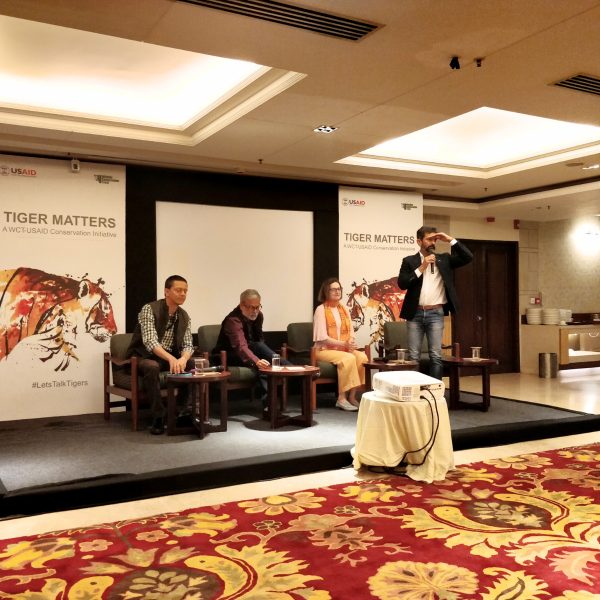‘We are seeds as well as parasites to the earth. We can either give or take, depending on our perception of growth,’ wrote Zephyr McIntyre and whenever we talk of the environment, the eco-system, wildlife, conservation, or even tigers, what matters more than anything else is perception. I have always believed that starting from the poacher who moves out each day to kill and ending with the paid activist who chants slogans on the streets without possibly understanding its impact, they are all good humans with a perception that needs the right tweak. Perception correction needs the right sort of people to get involved in conservation conversations and all this must be communicated as widely as possible. This also means that all channels of communication need to be activated… from the pages of the print media for limited geographies to the av-media for the couch potatoes to social media influencers for those with attention spans where even one minute is an unbelievable benchmark and finally to blogs that almost everyone who isn’t reading-challenged has the facility to access without regions, geographies, and time-spans creating intimidating obstacles. But what matters is that the environment matters… and if environment matters, tigers matter.
Tiger Matters
If you are wondering why anyone needs to focus on tigers while talking about conservation of our environment, Anish Andheria, President – Wildlife Conservation Trust has the answer. According to him the tiger is ‘a keystone species and its survival is crucial to the ecological as well as the economic security of India. Over 600 rivers originate or are fed by the tiger bearing forests of our country, which in turn ensures the sustainability of millions of Indians. Tiger conservation is nothing but conservation of healthy ecosystems and free flowing rivers.’ Statistics mentioned in Tiger Matters – A WCT-USAID Conservation Initiative, a video accessible by all on YouTube, point to around 3500 tigers now left in the wild and can be found in the forests of 13 countries. India has 65% of all wild tigers and currently supports over 2200 tigers – of this, 31% live in the central India landscape that has 20 tiger reserves. By the way, human population is also abundant and increasing in these areas and there are times some people find it impossible to conclude if it is we who are changing the tiger’s landscape or if it is the tiger’s landscape that is inexplicably changing. As I have mentioned earlier, there are many perceptions that need to be corrected.
So yes, tigers matter but so do all other animals. It is equally important to have forests that remain undisturbed by ever-increasing contours of human habitation. These seriousness of these infringements can be understood once we realise that in India we have over 400 species of mammals, over 305 species of snakes, over 1300 species of birds, over 1500 species of spiders, over 1500 species of butterflies, and 15 species of wild cats. Besides this we are fortunate to be living in a country that has 25000 species of flowering plants, a massive treasure of marine organisms, and wildlife preserved in 730 protected areas. Every aspect of our forests comes together in seamless ways that only nature understands and gives us an environment that we must be proud of. But environment matters are sensitive to a lot of actions that only humans are capable of conceiving and implementing and it is these actions that need attention.
What I am trying to say is that you, the ordinary citizen cannot possibly walk down a forest path and hold a poacher by his neck and you can hardly be expected to dive deep into the scientific relevance of having a thriving biodiversity. What you can do is to willingly read and listen to experts when they explain the why, what, when, and how of conservation and contribute by starting with conscious efforts to reduce your carbon footprint, by not littering, by not encouraging actions that may finally result in reducing our forest cover. The aam aadmi can also make sure that they transform into responsible social media influencers by sharing the right and authenticated bits of information that serve to improve information and knowledge about our environment, the efforts in motion to give conservation a boost, and add their voice in ways that may awaken the slumbering bureaucracy and our perpetually election-enthused politicians.
The forests that I am talking about are the ones that have a thriving combination of flora and fauna and the monkeys, chitals, goats, buffaloes, tigers and other animals have been doing their bit to keep them alive. They know what must thrive and where, they know the sort of plants that will help and must be proliferated… and they have doing this for ages. Human intervention is necessary only where human greed and need to expand thoughtlessly is in conflict with sensible human ideas that talk of conservation. The irony, however, is that even in this predominantly human conflict it is the tiger that has finally stepped in to become a symbol for resolution. No wonder then that Mary Melnyk, Environmental Security and Resilience team leader at USAID remarked: ‘Tigers are the golden thread of biodiversity in the fabric of all our lives. The journey in conservation is a long one and we are committed to walk every step of this journey with the aim to ensure that generations after us have a healthy environment.’
#LetsTalkTigers
One of the prime purposes of this post is to let the readers know that there are people and organisations working to protect our environment by protecting the tigers. Listen, the forest that I have talked about in this article is you. The forest is me. The tiger in many ways is helping preserve the forests and thus humanity… tiger conservation is symbolic of conservation of all life on earth.
The Tiger Matters program has already achieved a lot but needs to do more and without a break. Thus the support of each of us does matter. The people who have this conservation streak within have already done a lot according to their press release. The following points are taken from this release:
- Indicated the crucial functionality of corridors.
- Over 8,000 sq. km. of Central Indian Landscape camera trapped through 78,000 camera trap nights. Over 5,000 sq. km. of this was in the corridors.
- Detailed GIS mapping of 100,000 sq. km. carried out to understand the changes in landscape pattern across the Central Indian landscape.
- Drove the policy for the inclusion of Pench-Kanha, Pench-Nahzira, Nagzira-Tadoba, Tadoba-Melghat corridors in the tiger conservation plans of the respective tiger reserves.
- Helped the state of Maharashtra to publish a first-of-its-kind ‘State of the Tigers’ report based on the extensive camera trapping exercise.
- Discovery of the Eurasian Otter in Satpura Tiger reserve and Kanha-Pench corridor.
- Health needs assessment of close to 3,000 forest staff of the Central Indian Landscape.
- Over 46,000 children benefitted through an intensive education program in government schools situated in the buffer zones of tiger reserves.
There is obviously a lot that remains to be done. A lot remains to be done by us all. When I write this, people living inside forests as well as those who live in urban and semi-urban belts away from the reserves are included. Everyone must be empowered to work positively for tiger conservation. However what is true is that the local population has the power by default to save the environment more than even conservationists do. Legislation and official as well as conservationist interventions help but the people have more in their hands. This is the case with every other vital issue that we are aware of and includes environmental pollution, cleanliness of cities and villages, crime rates, security for women and children and so on.
.
.
.
.
Social media links for WCT:
Facebook | Twitter | Instagram | YouTube
.
.
Arvind Passey
04 December 2018












2 comments
Kesari says:
Dec 6, 2018
Thank you so much for sharing a great information. I appreciate your time and effort in your work. Keep posting.
Arvind Passey says:
Dec 10, 2018
Thanks for reading this post, buddy. Do visit my blog again…